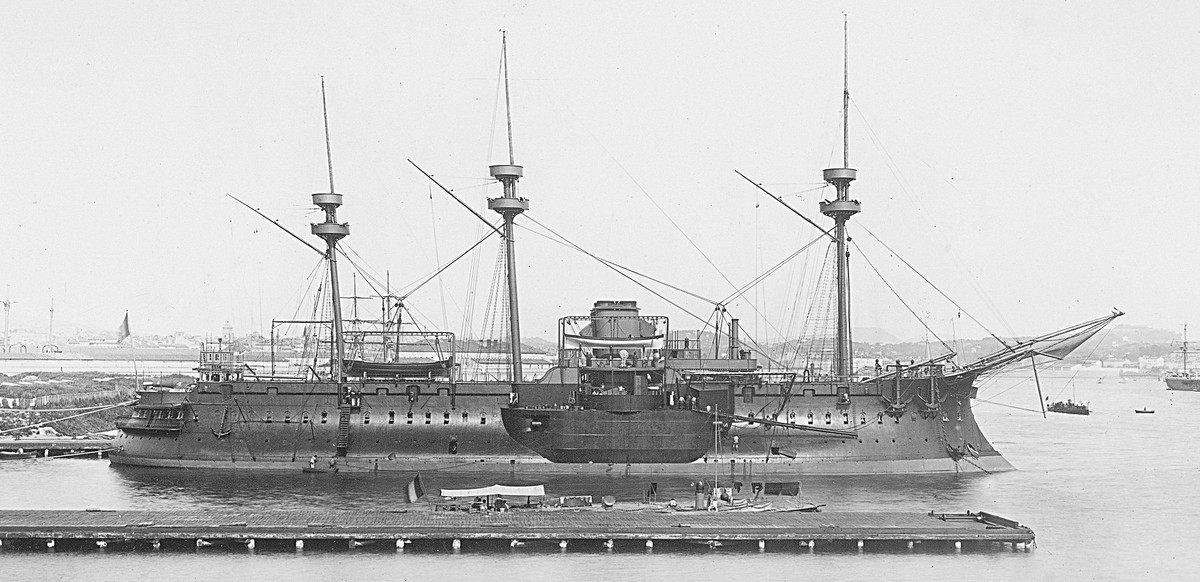
Le Redoutable (1878)
As the name suggests, ‘ironclad’ is used to designate 19th century warships that possessed two particular characteristics facilitated by the Industrial Revolution: a metal-covered hull and steam propulsion. Other than that, anything was fair game. At this time of constant innovation, countless different shapes, armor schemes, and gun configurations were sampled by the world’s most ambitious navies, making for weird ships such as these:
The four-flag ironclad: Stonewall 
This warship was designed and built in France for the Confederate Navy during the American Civil War, but in its long and turbulent career, she would also fly the ensigns of Spain, the United States, and Japan. Built with blockade-breaking in mind, Stonewall (Later Kotetsu), was fitted with a long iron ram on her bow, which, along with her two sailing masts and the long exhaust funnel planted on her deck, gave the ship the appearance of a sci-fi Roman trireme.
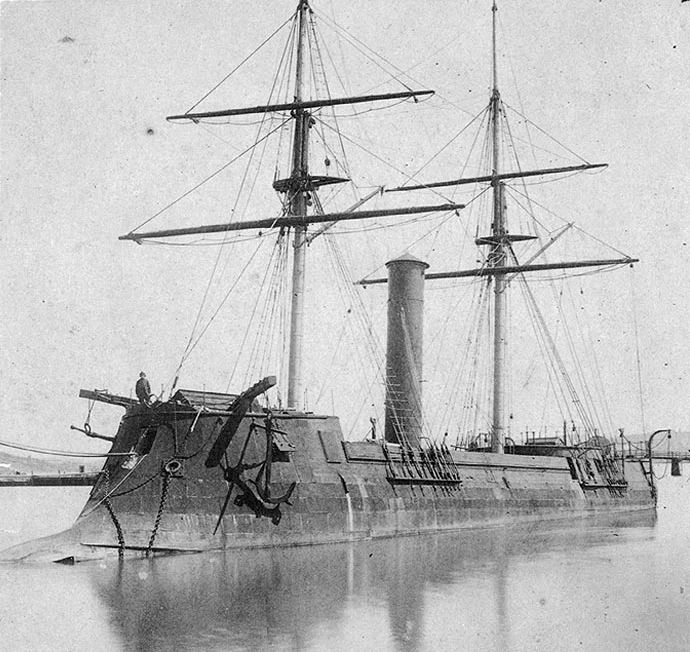
The River Monster:Cairo 
Like the previous ship, USS Cairo was built during the American Civil War, but served on the Unionist side as part of a river gunboat flotilla operating mostly in the Mississippi river, where she became the first ship to be sunk by a remotely detonated water mine. At 53 m long, Cairo was a rather compact warship but heavily armed, with more than 10 large caliber guns protruding from her almost rectangular angled hull from three sides, while the stern was reserved for the cylindrical paddle that drove her.
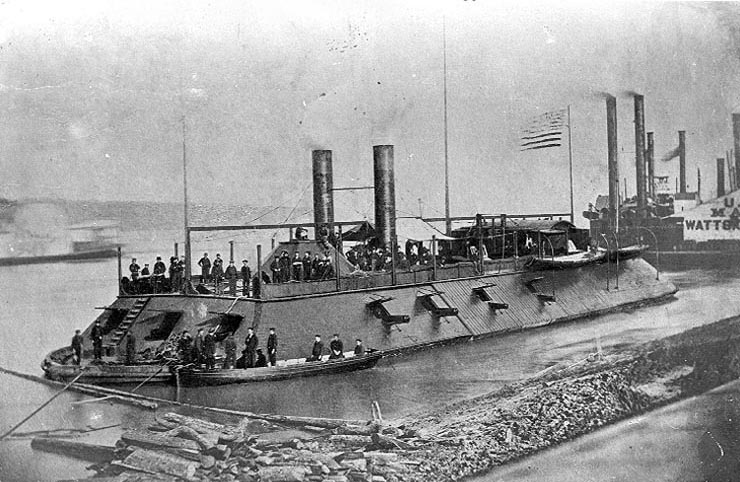
The Hellish Machine:Manassas 
A former icebreaker steamer, Manassas was acquired by the Confederate Navy and converted into an ironclad ram, though from a distance one might have thought it to be a small island with a smokestack, or a surfaced submarine. The only distinguishing features of this riverboat were that smokestack and the small porthole on her forward end, from which her single gun would emerge. Despite her almost absurd appearance, Manassas managed to ram and inflict significant damage upon two Union Navy ships at the battle of Forts Jackson and St. Philip in 1862.
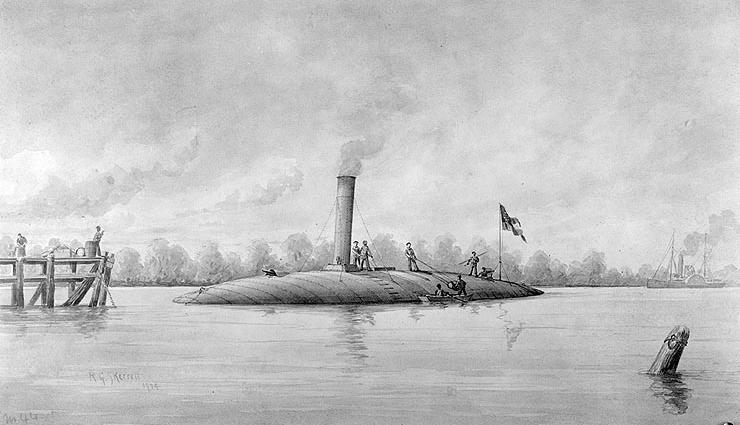
France’s Moving Castle:Carnot 
One of the weirdest warships of the 1800s was conceived at the very end of the century, with the pre-Dreadnought battleship Carnot. This iron colossus rose steeply out of the sea, with a bulbous protrusion extending all around her lower hull, covered with countless square portholes, only interrupted by the large caliber single-gun turrets spread throughout at varying levels. While her guns were never used in anger, the intimidation factor alone upon sighting her would likely have sent any enemy fleet running for the hills.
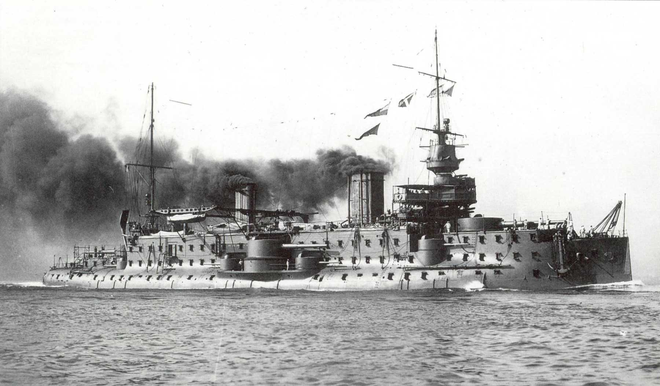
The Unequalled:Sans Pareil 
This Royal Navy battleship had an armored superstructure equipped with port holes extending around the entire rear-half of the ship. The lower fore-end was reserved for one massive turret that would house 2x 111-ton, 413 mm, breech-loading guns: the largest guns ever to be used on any British warship in history (bigger than the HMS Nelson’s 406 mm main battery!). While having tremendous damage potential, these guns were very slow to reload and had a tendency to droop and crack under their own immense weight, giving them a very impractical 75-shot life span.
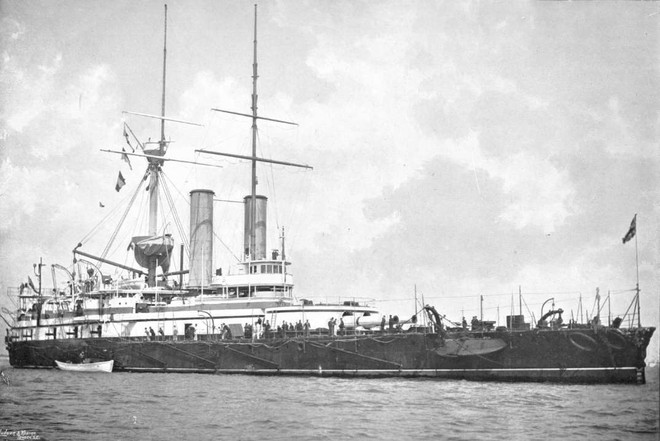
Tratto dal portale UE di WoW, strano post su Ironclads. Proprio ieri gli sviluppatori hanno detto che è possibile che potessimo vedere queste navi in gioco, un evento speciale come sottomarini durante Halloween.

Le Redoutable (1878)
Come suggerisce il nome, “nave corazzata” è la denominazione usata per navi da guerra del XIX secolo che possedevano in particolare due caratteristiche, rese possibili dalla rivoluzione industriale: uno scafo ricoperto d’acciaio e una propulsione a vapore. A parte questi due aspetti, le loro rimanenti caratteristiche erano le più svariate. Durante questo periodo di costante innovazione, innumerevoli forme, schemi e configurazioni di armamento differenti furono messi alla prova dalle nazioni più ambiziose. Ciò diede origine a navi strane come queste:
La nave corazzata con quattro vele: Stonewall 
Questa nave da guerra fu progettata e costruita in Francia, e doveva essere destinata alla Marina confederata durante la guerra di secessione americana. Ma durante la sua lunga e turbolenta carriera isserà anche le insegne spagnole, statunitensi e giapponesi. Costruita con lo scopo di spezzare il blocco navale, la Stonewall (successivamente ribattezzata Kotetsu), era equipaggiata con un lungo sperone d’acciaio installato a prua, che, insieme ai due alberi per le vele e al lungo fumaiolo posizionato sul ponte, le davano l’aspetto di una trireme romana fantascientifica.

Il mostro dei fiumi:Cairo 
Come la nave precedente, l’USS Cairo fu costruita durante la guerra civile americana, ma servì dalla parte dell’Unione all’interno di una flotta di cannoniere da fiume operante principalmente nel Mississippi, dove divenne la prima nave affondata da una mina a detonazione remota. Con la lunghezza di 53 m, la Cairo era una nave da guerra relativamente compatta, ma pesantemente armata, con più di 10 cannoni di grosso calibro che sporgevano da tre lati del suo scafo quasi rettangolare, mentre la parte a poppa era riservata alla ruota a pale che la spingeva.

La macchina infernale:Manassas 
Precedentemente era una rompighiaccio a vapore, la Manassas fu acquistata dalla Marina confederata e convertita in un ariete corazzato, anche se da lontano potrebbe sembrare una piccola isola o un sommergibile in emersione. Le uniche caratteristiche distintive di questa nave da fiume erano il suo fumaiolo e il piccolo oblò a prua, da cui poteva uscire il suo unico cannone. Nonostante il suo aspetto bizzarro, la Manassas riuscì a speronare e infiggere grossi danni a due navi dell’Unione durante la battaglia di Fort Jackson e Fort St. Philip nel 1862.

Il castello semovente francese:Carnot 
Alla fine del 1800 fu concepita la corazzata pre-dreadnought Carot, una delle più strane navi da guerra del XVIII secolo. Questo colosso di ferro, alto sopra il livello del mare, presentava una sporgenza bulbosa tutt’intorno al suo scafo inferiore, coperta da innumerevoli oblò quadrati e interrotta solo dalle grandi torrette a cannone singolo sparsi su vari livelli. Per quanto i suoi cannoni non siano mai stati usati in maniera offensiva, il mero fattore di intimidazione risultò sufficiente per far fuggire la flotta nemica.

L’ineguagliabile:Sans Pareil 
Questa corazzata della Royal Navy aveva una sovrastruttura corazzata dotata di oblò che si estendevano sull’intera metà posteriore della nave. L’astina di coda inferiore era riservata a una massiccia torretta che ospitava 2 cannoni a retrocarica da 413 mm e del peso di 111 tonnellate: si trattava dei cannoni più grandi mai utilizzati su qualsiasi corazzata britannica della storia (erano addirittura più grandi della batteria principale da 406 mm della HMS Nelson!). Pur vantando un enorme danno potenziale, questi cannoni erano molto lenti da ricaricare e avevano la tendenza a flettersi e a rompersi sotto il loro stesso peso, rendendo decisamente poco pratica la loro vita media pari a 75 colpi.

